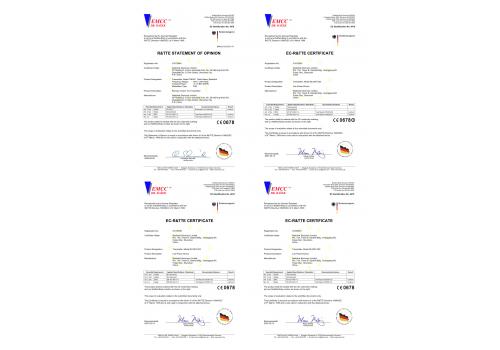Key Features:
Digital Display
6-channel 2.4GHz transmitter with servo reversing.
Easy to use control for basic models.
Includes 6-channel receiver
800 meter ground range
Included;
1 x 2.4Ghz transmitter
1 x 2.4Ghz Receiver
There is no bind plug - see review " The bind procedure is the easiest, quickest, no fuss seen to date, this is done by powering up the transmitter and receiver, then a tiny button positioned at the end of the receiver case is pressed once." It is inside the rectangular hole.
T6EAP 2.4GHZ RC SYSTEM
This is the plane version. At the moment there are no printed instructions available, but this model has all the same features and programming as the Futaba 6EXHP which are about 3 times the price. We haven't had time to test them yet so I have taken a review of one left by someone who got one instead of the heli version.
I've recently received this set and installed it in a 40-year old rudder elevator model. I've checked all the functions but not actually flown it yet (due weather and idleness). The set (labelled T6EAP) is plainly for fixed wing planes (which I wanted), not helicopters, and has all the same program functions as my Futaba T6EXAP, namely: ELVN, V-TL, FLTR, FLPR, PMX2, PMX1 (1 more than the Futaba), TRIM, EPA, D/R, EXPO and REVR. There is no way to name a model (that I can find) but I intend to write the model number on each plane. None of the heli functions such as N-PI, N-TH, REVO etc described in the manual are included in the Tx. Presumably there is another version (T6EHP???) for helicopters. In fact the manual describes the wrong Tx, being for the 35Mh helicopter set. If you're new to programming you will need the advice of an expert, or you could download the Futaba T6EXAP manual. Even that does not fully describe how to use each functions, but is better than nothing. To enter programming mode you need to hold down the 2 Mode buttons for a second or so (not the Select one as well as stated in the manual). You then cycle through the functions by pressing either Mode up arrow (forwards through the sequence above) or Mode down (backwards - useful as REVR is probably the most frequently used function). This is a minor advantage over the Futaba which only goes one way. You change the settings Data +/- and Settings - you'll have to experiment. I have still not reliably sorted how to set PMX1 and the D/R and EXPO functions. Being old and a bit slow I had a minor problem finding the Bind button on the receiver. It is very tiny, on the end beside the aerial. Once lightly pressed binding is virtually instant. Altogether the set seems to be very good value indeed, the only disadvantage being the manual. I haven't actually flown with it but so far am very pleased with it.
Easy mode change
This is a 6 function 2.4GHZ transmitter supplied with a matching 6 channel receiver. The example tested is a basic computer unit with a small easy to read top mounted LCD display. Helicopter flyers should find the transmitter’s functions are adequate for many types of model. Specific functions available are, model memory, servo reversing, exponentials, dual rates, throttle curve, idle up pitch curve, throttle hold, revo, swash plate select etc. Stick mode change is easy and involves swapping the throttle stick friction lever and some electronic changes made via the LCD screen. This particular unit has electronically operated trim button/switches rather than the electro mechanical lever type.
Audible warning
When checked on a power supply, the transmitter has a loud bleeper to indicate that the batteries are becoming discharged. The audible low voltage warning starts to operate at 8.4 volts. Either long life alkaline AA cells or NMH rechargeable cells can be used in the clip in battery holder. A standard charging jack is installed on one side of the transmitter. The small but useful instruction booklet provided covers all aspects of the computer programming section in reasonable detail. This is generally well written and easy to understand having been translated into a good standard of English which is a pleasant surprise. Numerous illustrations regarding the LCD and transmitter programming have been included.
Very fast bind
As with the non computer systems tested, the bind procedure is amazingly fast and without any fuss. Having plugged in a servo or 2 and suitable battery, the units are ready for the binding procedure. With both units switched on, the receivers green LED will be illuminated. After gently pressing the bind button in the centre of receiver case end, the LED will flash a few times then stop as the bind procedure is completed in a matter of seconds. The R6DH receiver is generic to both T6HP and T4U 2.4GHZ systems. Due to the immense choice of servos now available, none are supplied with this transmitter-receiver combination. Although orientated towards helicopters, this combo outfit should also find favour with fixed wing sport model flyers who want an easy to use computer transmitter.
Range
A basic but impressive ground range test was done at a flying field with the receiver, 2 servos and a battery pack hung in a tree about 5 feet above ground level. This test involved the transmitter being unfairly taken down a slope making it out of line of sight and below the operating horizon, yet a positive lock was maintained at all times.
Conclusion: Outstanding value for money. This is no nonsense easy to set up, plug and play entry level computer radio. Ideal for those who may dislike the very complex systems which often need the huge user manual to be carried at all times. For instance: Servo reversing see page 211 etc.







